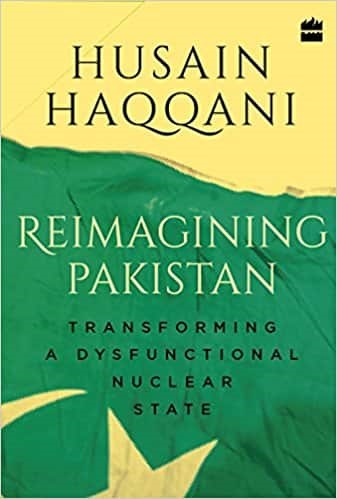The debate on Pakistan’s contemporary status in the changing regional and international strategic environment has started a new chapter in the history of the nuclearized subcontinent. Presently, critical circles of international community generally prefer to negatively examine the various phases of Pakistan’s political crisis and economic problems. In this way, an overwhelming wave of literature based on academic and journalistic analyses choose to study Pakistan’s internal and external problems by adopting critical lens. Husain Haqqani’s recent study Reimaging Pakistan is an addition to such literature. A former Pakistan’s ambassador to the Unites States, Haqqani served as advisor to three prime ministers of Pakistan. Presently, he is Senior Fellow and Director for South and Central Asia at Hudson Institute. While living in the United States and serving in Washington based think tank, he has very unfavorably inspected Pakistani social, political, and economic structures in different writings. The book under review presents an overview of his personal way of looking at Pakistan.
The book is divided into eight chapters and every chapter attempts to cover a separate topic by providing brief arguments. In other words, it is a collection of several arguments on eight different topics. In the initial pages, the writer attempts to provide a glimpse of his visualization of Pakistan by calling it as a “dangerous, unstable, terrorist incubator, fragile, and the land of the intolerant” (p. ix). Additionally, he compares Pakistan’s economic complications with different African and South Asian countries by citing selected surveys of various organizations in the first chapter. The subsequent chapters continue the discussion by specifically highlighting the difficult phases of Pakistan’s political evolution. Further a negative discussion on the partition of the subcontinent describes the Two Nation theory, and matches it with the two-nation theory of Ireland adopted in 1913 (p. 53). Islamabad’s position between Beijing and Washington on economic front parallel to Pakistan’s status between Riyadh and Tehran in ideological matters is abstrusely emphasised by the writer in the second chapter. The question of Pakistan’s creation is supplementary answered by Salman Rushdie’s argument in which Rushdie calls Pakistan as a country “insufficiently imagined” (p. 59). In order to undermine the ideological foundations of Pakistan, this research uses the references of different profanity literatures (pp. 109-112).
In the end, this research echoes seven self-imagined paradoxes which are purely the writer’s own ridiculous imagination of Pakistan’s history, its geographical location and ideological roots. The concluding part of this study mentions five suggestions based on a specific mind-set of the writer which could be helpful in overhauling existing institutional, religious, and ethnic arrangements of Islamabad. These suggestions are developed to address the five critical faultiness of the country. So, the conclusion of the book stresses the re-conceptualization of the country which is the only nuclear power in the Islamic world and home to 210 million people. This book is a comprehensive story of Pakistan in which the writer is reluctant to even acknowledge the positive improvement in Islamabad’s regional and international standings. The book focuses more on Pakistan’s internal and external crises, and less emphases is given on the progressive steps the country has taken throughout history.
Haqqani’s inspection of Pakistani political system denies Islamabad’s role in stabilizing South Asian region. He refuses to consider Islamabad’s position in empowering the counterbalancing forces against Indian regional designs cemented in New Delhi’s regional hegemonic inspirations. Equivalent to a specific examination of regional strategic environment of South Asian, he inspects Islamabad’s role very unfavourably in the extra-regional affairs. Without mentioning Islamabad’s efforts in the US-led global war on terror, he says Pakistan’s efforts in its fight against terrorism are insufficient. Such analysis ignores the sacrifices of the Pakistani nation. In addition to regional and extra-regional analysis, the book offers an acute analytical account of Pakistan’s internal problems. But instead of describing an impartial and balanced picture of Pakistan, the book speaks about Haqqani’s personal views and individual visualization of Islamabad’s political system. Thus, the book focuses less on national security mechanism of Islamabad by explaining the nature of threats Pakistan is facing presently. An ambiguous matrix of internal and external conflicts has pushed the Pakistani nation into a serious situation in which leading state officials from Islamabad are trying to escape instead of seriously addressing the security challenges to their country, according to writer.
The central theme of the book suggests redefining or reconstructing of traditional national attributes of Pakistan. Such ideas of this writer refers to re-imagination of every conventional value relevant to Pakistan’s historical roots, ideological foundations, political structure, economic system, and social arrangement. Moreover, revision of main foreign policy decision making process with reference to neighbouring countries, Muslim world, and great powers are also essential for the government of Pakistan. According to the writer, a vivid change in the traditional threat perception mechanism along with overlooking fundamental national security issues of Islamabad can improve Pakistan’s role in the existing international system. In short, the writer intentionally (or unintentionally) challenges Pakistan’s political, diplomatic, strategic, economic, and cultural attributes.
Akin to his recent book, Haqqani’s previous books failed to forge impartially a positive reflection of his intellectual insight. Prior to his present book, his earlier writings have also tried to undermine Islamabad’s role in South Asian region. He usually enjoys comparing Pakistan with other third world nations and underestimates the leading state infrastructures of Islamabad. He hopes to change the traditional image of his country in international world politics by humiliating the national image of country globally. Despite its length and repetitions, it presents no remedial mechanism. There is no concerted effort to present a course that would set the prevalent ill-conceived self-image of victim-hood on a path towards cooperative self-correction.





